Arijit Khan
Finding Counterfactual Evidences for Node Classification
May 16, 2025Abstract:Counterfactual learning is emerging as an important paradigm, rooted in causality, which promises to alleviate common issues of graph neural networks (GNNs), such as fairness and interpretability. However, as in many real-world application domains where conducting randomized controlled trials is impractical, one has to rely on available observational (factual) data to detect counterfactuals. In this paper, we introduce and tackle the problem of searching for counterfactual evidences for the GNN-based node classification task. A counterfactual evidence is a pair of nodes such that, regardless they exhibit great similarity both in the features and in their neighborhood subgraph structures, they are classified differently by the GNN. We develop effective and efficient search algorithms and a novel indexing solution that leverages both node features and structural information to identify counterfactual evidences, and generalizes beyond any specific GNN. Through various downstream applications, we demonstrate the potential of counterfactual evidences to enhance fairness and accuracy of GNNs.
Generating Skyline Explanations for Graph Neural Networks
May 12, 2025Abstract:This paper proposes a novel approach to generate subgraph explanations for graph neural networks GNNs that simultaneously optimize multiple measures for explainability. Existing GNN explanation methods often compute subgraphs (called ``explanatory subgraphs'') that optimize a pre-defined, single explainability measure, such as fidelity or conciseness. This can lead to biased explanations that cannot provide a comprehensive explanation to clarify the output of GNN models. We introduce skyline explanation, a GNN explanation paradigm that aims to identify k explanatory subgraphs by simultaneously optimizing multiple explainability measures. (1) We formulate skyline explanation generation as a multi-objective optimization problem, and pursue explanations that approximate a skyline set of explanatory subgraphs. We show the hardness for skyline explanation generation. (2) We design efficient algorithms with an onion-peeling approach that strategically removes edges from neighbors of nodes of interests, and incrementally improves explanations as it explores an interpretation domain, with provable quality guarantees. (3) We further develop an algorithm to diversify explanations to provide more comprehensive perspectives. Using real-world graphs, we empirically verify the effectiveness, efficiency, and scalability of our algorithms.
CoT-RAG: Integrating Chain of Thought and Retrieval-Augmented Generation to Enhance Reasoning in Large Language Models
Apr 18, 2025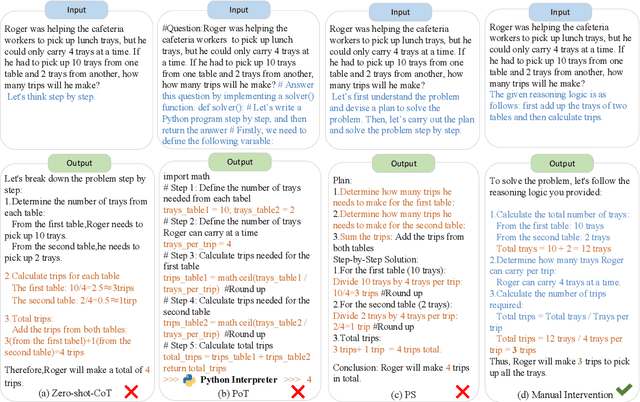

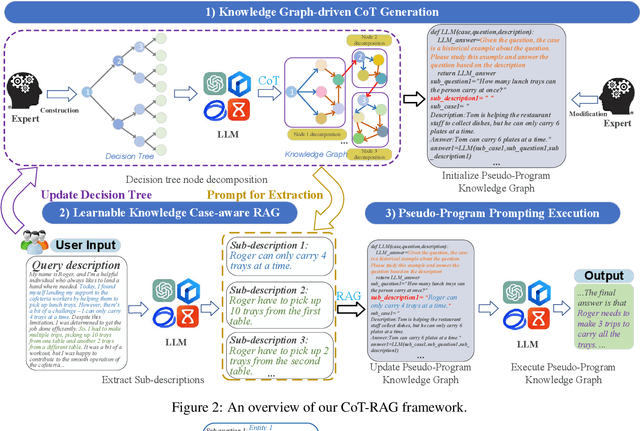

Abstract:While chain-of-thought (CoT) reasoning improves the performance of large language models (LLMs) in complex tasks, it still has two main challenges: the low reliability of relying solely on LLMs to generate reasoning chains and the interference of natural language reasoning chains on the inference logic of LLMs. To address these issues, we propose CoT-RAG, a novel reasoning framework with three key designs: (i) Knowledge Graph-driven CoT Generation, featuring knowledge graphs to modulate reasoning chain generation of LLMs, thereby enhancing reasoning credibility; (ii) Learnable Knowledge Case-aware RAG, which incorporates retrieval-augmented generation (RAG) into knowledge graphs to retrieve relevant sub-cases and sub-descriptions, providing LLMs with learnable information; (iii) Pseudo-Program Prompting Execution, which encourages LLMs to execute reasoning tasks in pseudo-programs with greater logical rigor. We conduct a comprehensive evaluation on nine public datasets, covering three reasoning problems. Compared with the-state-of-the-art methods, CoT-RAG exhibits a significant accuracy improvement, ranging from 4.0% to 23.0%. Furthermore, testing on four domain-specific datasets, CoT-RAG shows remarkable accuracy and efficient execution, highlighting its strong practical applicability and scalability.
Knowledge Graph-based Retrieval-Augmented Generation for Schema Matching
Jan 15, 2025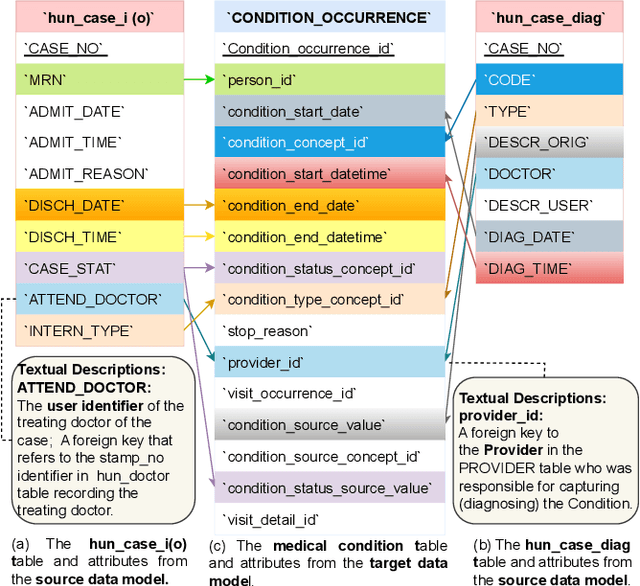
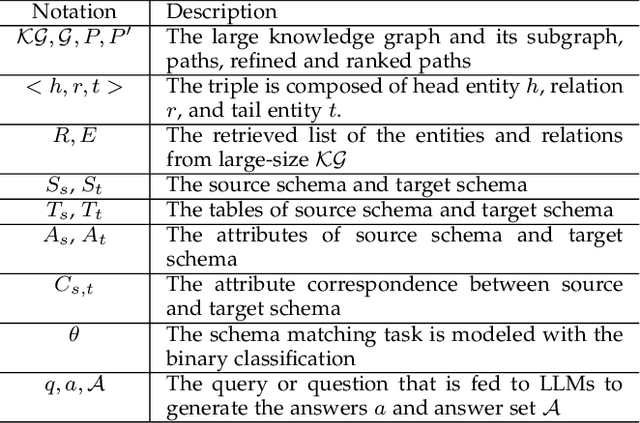
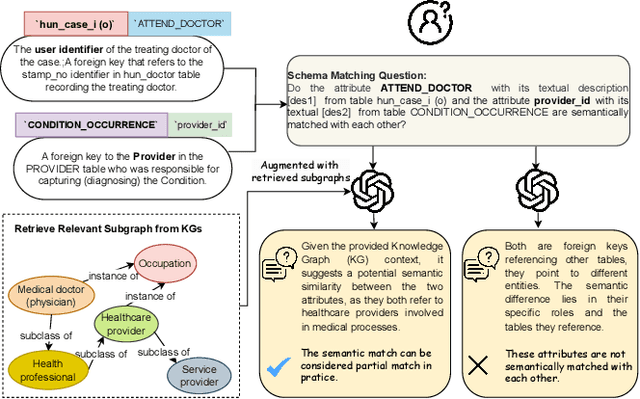
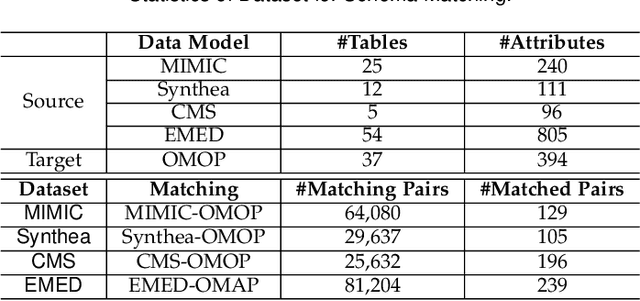
Abstract:Traditional similarity-based schema matching methods are incapable of resolving semantic ambiguities and conflicts in domain-specific complex mapping scenarios due to missing commonsense and domain-specific knowledge. The hallucination problem of large language models (LLMs) also makes it challenging for LLM-based schema matching to address the above issues. Therefore, we propose a Knowledge Graph-based Retrieval-Augmented Generation model for Schema Matching, referred to as the KG-RAG4SM. In particular, KG-RAG4SM introduces novel vector-based, graph traversal-based, and query-based graph retrievals, as well as a hybrid approach and ranking schemes that identify the most relevant subgraphs from external large knowledge graphs (KGs). We showcase that KG-based retrieval-augmented LLMs are capable of generating more accurate results for complex matching cases without any re-training. Our experimental results show that KG-RAG4SM outperforms the LLM-based state-of-the-art (SOTA) methods (e.g., Jellyfish-8B) by 35.89% and 30.50% in terms of precision and F1 score on the MIMIC dataset, respectively; KG-RAG4SM with GPT-4o-mini outperforms the pre-trained language model (PLM)-based SOTA methods (e.g., SMAT) by 69.20% and 21.97% in terms of precision and F1 score on the Synthea dataset, respectively. The results also demonstrate that our approach is more efficient in end-to-end schema matching, and scales to retrieve from large KGs. Our case studies on the dataset from the real-world schema matching scenario exhibit that the hallucination problem of LLMs for schema matching is well mitigated by our solution.
Logical Consistency of Large Language Models in Fact-checking
Dec 20, 2024Abstract:In recent years, large language models (LLMs) have demonstrated significant success in performing varied natural language tasks such as language translation, question-answering, summarizing, fact-checking, etc. Despite LLMs' impressive ability to generate human-like texts, LLMs are infamous for their inconsistent responses -- a meaning-preserving change in the input query results in an inconsistent response and attributes to vulnerabilities of LLMs such as hallucination, jailbreaking, etc. Consequently, existing research focuses on simple paraphrasing-based consistency assessment of LLMs, and ignores complex queries that necessitates an even better understanding of logical reasoning by an LLM. Our work therefore addresses the logical inconsistency of LLMs under complex logical queries with primitive logical operators, e.g., negation, conjunction, and disjunction. As a test bed, we consider retrieval-augmented LLMs on a fact-checking task involving propositional logic queries from real-world knowledge graphs (KGs). Our contributions are three-fold. Benchmark: We introduce three logical fact-checking datasets over KGs for community development towards logically consistent LLMs. Assessment: We propose consistency measures of LLMs on propositional logic queries as input and demonstrate that existing LLMs lack logical consistency, specially on complex queries. Improvement: We employ supervised fine-tuning to improve the logical consistency of LLMs on the complex fact-checking task with KG contexts.
Enhancing Glucose Level Prediction of ICU Patients through Irregular Time-Series Analysis and Integrated Representation
Nov 03, 2024



Abstract:Accurately predicting blood glucose (BG) levels of ICU patients is critical, as both hypoglycemia (BG < 70 mg/dL) and hyperglycemia (BG > 180 mg/dL) are associated with increased morbidity and mortality. We develop the Multi-source Irregular Time-Series Transformer (MITST), a novel machine learning-based model to forecast the next BG level, classifying it into hypoglycemia, hyperglycemia, or euglycemia (70-180 mg/dL). The irregularity and complexity of Electronic Health Record (EHR) data, spanning multiple heterogeneous clinical sources like lab results, medications, and vital signs, pose significant challenges for prediction tasks. MITST addresses these using hierarchical Transformer architectures, which include a feature-level, a timestamp-level, and a source-level Transformer. This design captures fine-grained temporal dynamics and allows learning-based data integration instead of traditional predefined aggregation. In a large-scale evaluation using the eICU database (200,859 ICU stays across 208 hospitals), MITST achieves an average improvement of 1.7% (p < 0.001) in AUROC and 1.8% (p < 0.001) in AUPRC over a state-of-the-art baseline. For hypoglycemia, MITST achieves an AUROC of 0.915 and an AUPRC of 0.247, both significantly higher than the baseline's AUROC of 0.862 and AUPRC of 0.208 (p < 0.001). The flexible architecture of MITST allows seamless integration of new data sources without retraining the entire model, enhancing its adaptability in clinical decision support. Although this study focuses on predicting BG levels, MITST can easily be extended to other critical event prediction tasks in ICU settings, offering a robust solution for analyzing complex, multi-source, irregular time-series data.
LLM+KG@VLDB'24 Workshop Summary
Oct 02, 2024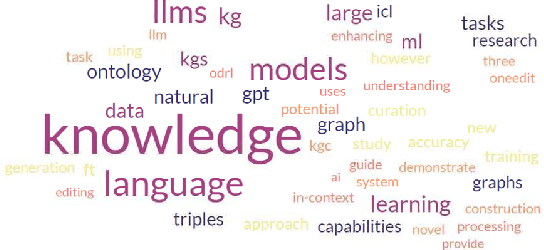
Abstract:The unification of large language models (LLMs) and knowledge graphs (KGs) has emerged as a hot topic. At the LLM+KG'24 workshop, held in conjunction with VLDB 2024 in Guangzhou, China, one of the key themes explored was important data management challenges and opportunities due to the effective interaction between LLMs and KGs. This report outlines the major directions and approaches presented by various speakers during the LLM+KG'24 workshop.
Generating Robust Counterfactual Witnesses for Graph Neural Networks
Apr 30, 2024



Abstract:This paper introduces a new class of explanation structures, called robust counterfactual witnesses (RCWs), to provide robust, both counterfactual and factual explanations for graph neural networks. Given a graph neural network M, a robust counterfactual witness refers to the fraction of a graph G that are counterfactual and factual explanation of the results of M over G, but also remains so for any "disturbed" G by flipping up to k of its node pairs. We establish the hardness results, from tractable results to co-NP-hardness, for verifying and generating robust counterfactual witnesses. We study such structures for GNN-based node classification, and present efficient algorithms to verify and generate RCWs. We also provide a parallel algorithm to verify and generate RCWs for large graphs with scalability guarantees. We experimentally verify our explanation generation process for benchmark datasets, and showcase their applications.
Machine Learning for Blockchain Data Analysis: Progress and Opportunities
Apr 28, 2024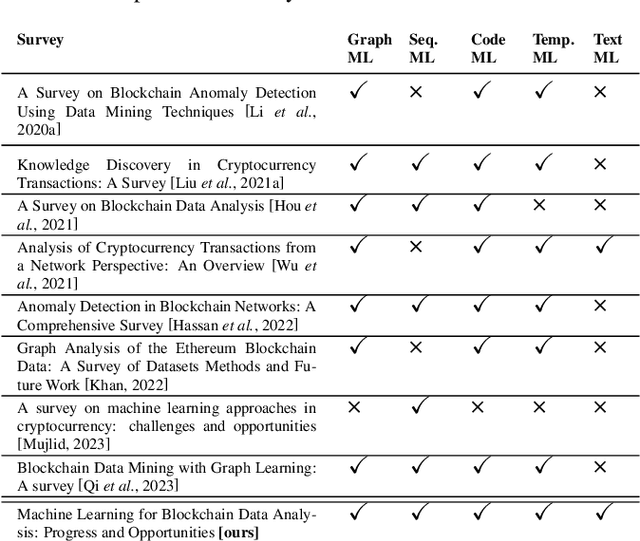
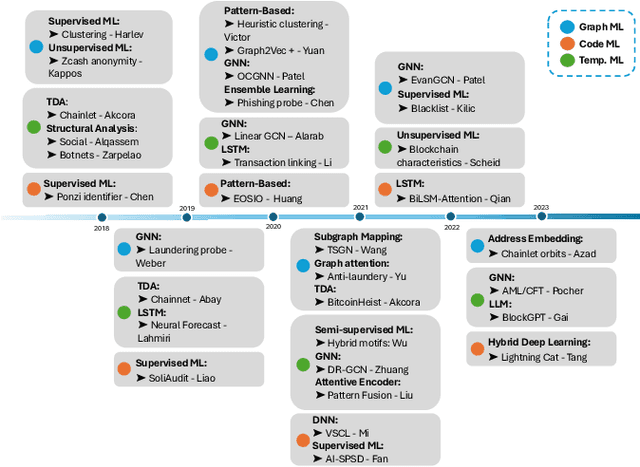
Abstract:Blockchain technology has rapidly emerged to mainstream attention, while its publicly accessible, heterogeneous, massive-volume, and temporal data are reminiscent of the complex dynamics encountered during the last decade of big data. Unlike any prior data source, blockchain datasets encompass multiple layers of interactions across real-world entities, e.g., human users, autonomous programs, and smart contracts. Furthermore, blockchain's integration with cryptocurrencies has introduced financial aspects of unprecedented scale and complexity such as decentralized finance, stablecoins, non-fungible tokens, and central bank digital currencies. These unique characteristics present both opportunities and challenges for machine learning on blockchain data. On one hand, we examine the state-of-the-art solutions, applications, and future directions associated with leveraging machine learning for blockchain data analysis critical for the improvement of blockchain technology such as e-crime detection and trends prediction. On the other hand, we shed light on the pivotal role of blockchain by providing vast datasets and tools that can catalyze the growth of the evolving machine learning ecosystem. This paper serves as a comprehensive resource for researchers, practitioners, and policymakers, offering a roadmap for navigating this dynamic and transformative field.
View-based Explanations for Graph Neural Networks
Jan 08, 2024



Abstract:Generating explanations for graph neural networks (GNNs) has been studied to understand their behavior in analytical tasks such as graph classification. Existing approaches aim to understand the overall results of GNNs rather than providing explanations for specific class labels of interest, and may return explanation structures that are hard to access, nor directly queryable.We propose GVEX, a novel paradigm that generates Graph Views for EXplanation. (1) We design a two-tier explanation structure called explanation views. An explanation view consists of a set of graph patterns and a set of induced explanation subgraphs. Given a database G of multiple graphs and a specific class label l assigned by a GNN-based classifier M, it concisely describes the fraction of G that best explains why l is assigned by M. (2) We propose quality measures and formulate an optimization problem to compute optimal explanation views for GNN explanation. We show that the problem is $\Sigma^2_P$-hard. (3) We present two algorithms. The first one follows an explain-and-summarize strategy that first generates high-quality explanation subgraphs which best explain GNNs in terms of feature influence maximization, and then performs a summarization step to generate patterns. We show that this strategy provides an approximation ratio of 1/2. Our second algorithm performs a single-pass to an input node stream in batches to incrementally maintain explanation views, having an anytime quality guarantee of 1/4 approximation. Using real-world benchmark data, we experimentally demonstrate the effectiveness, efficiency, and scalability of GVEX. Through case studies, we showcase the practical applications of GVEX.
 Add to Chrome
Add to Chrome Add to Firefox
Add to Firefox Add to Edge
Add to Edge